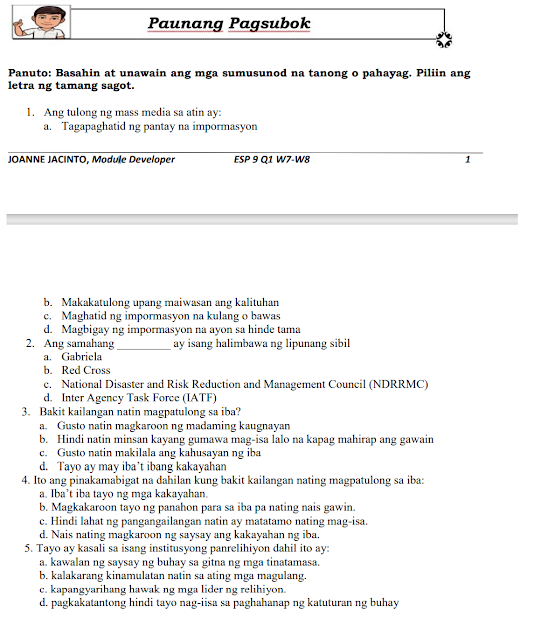SOLAR SYSTEM: REVIEWER
INTEGRATED SCIENCE
4RTH QUARTER REVIEWER
NAME: ___________________________________________________________DATE:_______________SCORE_____/_____
I: MULTIPLE CHOICES: Encircle the letter that corresponds to the word or words that will correctly complete the sentence.
1. The earth crust that makes up the continents is called_________________________.
a. Lithosphere b. oceanic crust c. trench d. continental crust e. tectonic plates
2. The melted rock the flows from a volcano and reaches the earth’s surface is called___________________.
a. Granite b. lava c. magma d. pumice e. ashes
3. A vent in the earth’s surface through which the magma and gases erupt.
a. Mountain arch’s b. volcano c. asthenosphere d. oceanic crust e. subduction zone
4. A piece of granite having small crystals was formed ________________.
a. Quickly b. slowly c. with water d. with gas bubbles e. shinny with sediment
5. A type of rock from a cooling magma is called_______________________________.
a. Granite b. crystals c. igneous d. metamorphic e. sedimentary
6. A fold is ____________________.
a. Fault b. joint c. rift d. rift e. bend of rock
7. Most plates contain ________________________.
a. Continents b. only oceanic plates c. both continental and oceanic plates d. only continental plates
8. The source of the forces that move plates is called_________________________.
a. Gravity b. magnetism c. the earth’s rotation d. convection current e. conduction current
9. All of these are form of erosion by water except ____________________.
a. Blowing away of the soil b. waves crashing into the rocks c. carrying away of sediments by river
d. a flooding river carrying away topsoil e. heavy rain in an area.
10. The most abundant gas in the atmosphere is ________________.
a. methane b. oxygen c. nitrogen d. helium e. carbon dioxide
11. The lowest layer of the atmosphere is called the _______________________.
a. mesosphere b. troposphere c. stratosphere d. thermosphere e. ionosphere
12. Ultraviolet radiation from the sun is absorbed by ozone in the_____________________.
a. ionosphere b. stratosphere c. thermosphere d. troposphere e. mesosphere
13. The lower thermosphere is called the _________________________.
a. stratosphere b. mesosphere c. thermosphere d. troposphere. Ionosphere
14. The percentage of carbon dioxide in the atmosphere is approximately ____________________.
a. less than 1 percent b. 21 %` c.78% d. 99% e. 50 %
15. Bacteria in the soil turn atmospheric nitrogen into _______________.
a. methane b. oxygen c. nitrates d. carbon e. helium
16. Scientist are concerned that the burning of fuels is increasing too much of ____________ in the atmosphere.
a. nitrogen b. ozone c. oxygen d. carbon dioxide e. sulfur oxide
17. The atmosphere is divided into layers according to major changes in ______________ .
a. pressure b. temperature c. air flow d. the kinds of gases it contains e. the amount of gas
18. Earth’s weather generally occurs in the ______________________________.
a. mesosphere b. stratosphere c. thermosphere d. thermoshere e. ionosphere
19. Ultra violet rays and x-rays caused charges particles to form in the ______________________.
a. exosphere b. ionosphere c. stratosphere d. troposphere E. ionosphere
20. Compared to warm air, cold air is ______________ for a given volume.
a. lighter b. more dense c. less dense d. about same density
21. The layer where electrically charged particles are found is called________________________.
a. exosphere b. stratosphere c. thermosphere d. troposphere e. ionosphere
22. The layer of the atmosphere where air is very thin is called the_____________________________.
a. exosphere b. stratosphere c. thermosphere d. troposphere e.ionosphere
23. The layer in which the temperature drops its altitude is called _____________________.
a. exosphere b. stratosphere c. thermosphere d. troposphere e. ionosphere
24. Beyond the exosphere is a region where radioactive particles form a layer called ______________.
a. ionosphere b. mesosphere c. stratosphere d. aurora e. Van Allen Belt
25. Air pressure decreases as alttitude increases because ____________________.
a. there are less clouds


Mga Komento